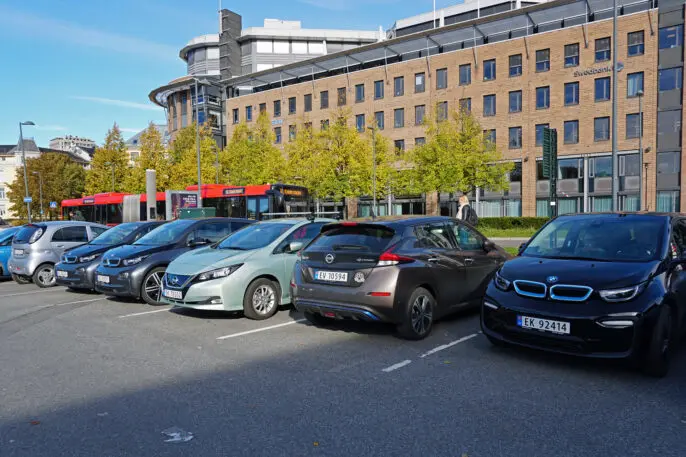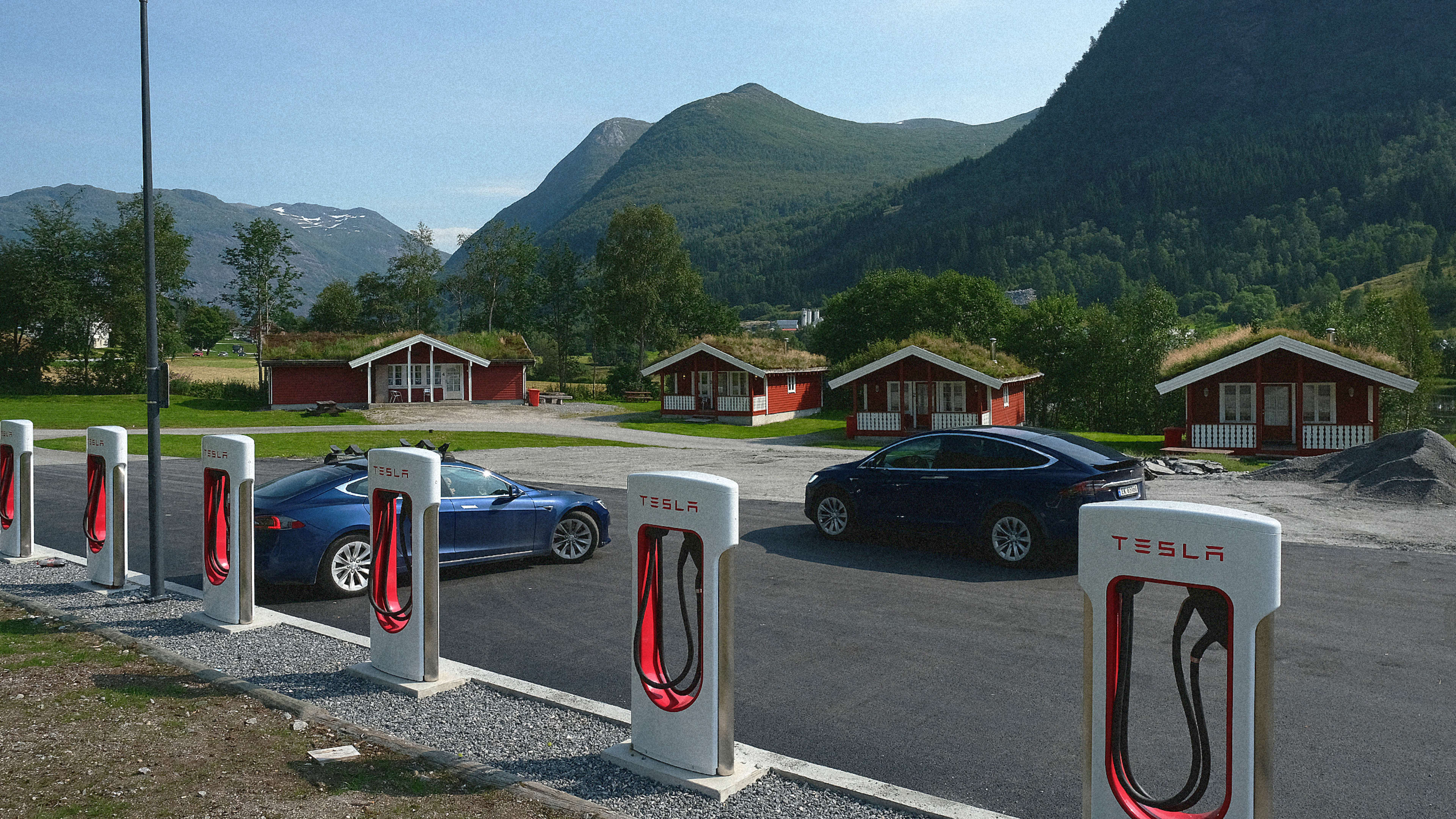This article originally appeared in Nexus Media News and Reasons to Be Cheerful and is part of their series on the New Climate Economy.
When Trondheim-based Magnus Korpås bought his first electric car in 2019, he settled on a Tesla—the model that offered the most charging stations available to him at the time. However, in just a few years, Norway built out its charging infrastructure so quickly that no matter what type of electric vehicle you choose, there’s virtually always a charging point nearby.
“In Norway, we’re quite used to electric vehicles. This is the common car now,” says Korpås, a professor at the Norwegian University of Science and Technology. “You diverge from the standard if you buy something else, really.”
For the past three decades, Norway has doggedly endeavored to electrify its vehicle fleet, using a mix of infrastructure investments, subsidies, and regulations to nudge people into electric cars. The results have been remarkable: 20% of cars on the road are EVs, and Norway was the first country in the world to see EV car sales begin to outpace those of fossil fuel cars. Today, 80% of new cars sold in Norway are electric.

By comparison, the U.S. is woefully lagging. It is estimated that less than 1% of cars on U.S. roads are electric, and while EV sales are rapidly growing stateside, they still account for just under 5% of new cars sold in the country. The Inflation Reduction Act (IRA) is meant to help speed the transition from fossil fuel cars to EVs as part of a bid to reduce the country’s greenhouse gas emissions, about 27% of which are attributable to transportation.
While the IRA is designed to promote EV uptake through purchase subsidies, it simultaneously aims to vastly expand the U.S.’s EV charging network. Range anxiety, concern that a car will run out of charge while out on the road, is a significant factor keeping Americans from buying EVs. While many climate advocates argue that reducing transportation emissions requires strengthening public transit options and making cities more bikeable and walkable, promoting EV adoption is the fix most prominent in the IRA.
“There’s strong consensus that vehicle electrification is a big part of the [climate] solution. But you can’t do that without having the charging infrastructure,” says Ben Shapiro, manager of the Carbon-Free Transportation team at the clean energy think tank Rocky Mountain Institute. “From a climate perspective, it’s imperative.”
According to Shapiro, the U.S. needs “orders of magnitude more charging infrastructure than we have today” to reach its goal of making half of all vehicle sales zero-emissions by 2030. Norway—which has more EVs per capita, and more chargers per EV, than any other place in the world—offers a road map for how to get there.
***
Up to this point, EV charging infrastructure in the U.S. has been driven largely by private investment. Tesla has installed more than 163,000 chargers across the country, but its chargers work only on Teslas (though that’s scheduled to change soon). In January, Mercedes-Benz announced that it would install 2,500 high-powered chargers that will work with any car by 2027, following Volkswagen’s 2021 announcement that it planned to have 10,000 fast chargers deployed in North America by 2025.
In Norway, too, Tesla was the first major commercial player to begin building out public charging stations in an effort to make its product more appealing. As EV adoption continued to increase in the 2000s and 2010s, the Norwegian government stepped in to ensure charging points were easy to use and equitably distributed. It invested 7 million euros (nearly $7.5 million) to create 1,900 charging points by 2011.
Parallel measures to increase charging accessibility started to ramp up in the U.S. with the passage of the IRA in 2022. The bill invests $7.5 billion in EV charging with the goal of building out a network of 500,000 chargers across the nation by 2030. It also restores expired tax credits for installing EV chargers in low-income communities and rural areas. The Biden administration finalized new standards that will make U.S. charging infrastructure available to everyone, regardless of what brand of car they drive. (Tesla’s formerly exclusive Supercharger network will soon be open to all brands of EVs).
Norway offers additional lessons for prioritizing equity. Since more than 82% of EV users in Norway charge their vehicles at home, housing associations can apply for grants that subsidize up to 50% of the cost of buying and installing communal chargers. The Norwegian government also created “a law that parking garages have to establish the basic infrastructure, like having the electricity available,” says Petter Haugneland, assistant general secretary of the Norwegian EV Association.
***
Analysis from S&P Global estimates that the U.S. needs to quadruple the number of EV chargers between 2022 and 2025 to keep pace with the EVs that will be on the road. If Norway’s experience is any indicator, encouraging EV adoption itself might be the best tool the U.S. has to increase charger proliferation.
According to Korpås, Norway’s path to charging-point saturation started by stimulating more demand for EVs—just as the U.S. has done with EV purchase tax credits embedded in the IRA. But while the U.S. incentivizes EV purchases, Norway also disincentivizes purchases of nonelectric cars. Its “polluter pays” principle means that fossil fuel cars are taxed higher than EVs. The purchase tax on fossil fuel-burning cars is calculated by a combination of weight and emissions, which means bigger, more polluting cars are more expensive.
Because Norway is a cold country that had already built out extensive grid capacity to handle the population’s heating needs—most of which are met with electricity—the Norwegian grid was decently equipped to handle the energy demand from EVs, Korpås says. In other words, the grid infrastructure was already in place even if public chargers were not.
Much like Norway, about 80% of EV charging in the U.S. happens at home. But the U.S.’s grid doesn’t have as much relative capacity as Norway’s, in part because the U.S. tends to rely more on natural gas for heating. Expanding EV charging infrastructure in the U.S. will rely more on building out the electrical grid’s overall capacity than on building additional public charging ports.
Another contributing factor to Norway’s success in adopting EVs is its deep pockets—which is, in no small part, due to its status as a major oil exporter. The country of 5 million people collected almost $90 billion in tax revenue from the oil and gas industry last year, according to Norwegian officials, and its per capita gross domestic product is $20,000 more than that of the United States, per World Bank data. And while the IRA has freed up funding for climate initiatives stateside, many decarbonization projects have and will continue to run into dead ends until the U.S. begins to more proactively plan its grid build-out.
“There’s a pretty significant investment that will need to take place to support all of this new electrical demand,” says Shapiro of the Rocky Mountain Institute. “That’s not only an electric utility issue; that’s also a regulatory issue. We have a lot of work to do from an electric sector public policy perspective to enable the utilities to move more quickly on this to get ahead of the growing demand for charging.” Part of what that means, he says, is streamlining the permitting process so utilities can quickly invest in infrastructure that can anticipate future electricity needs.
According to Haugneland, the Norwegian EV Association’s members use public fast chargers about twice per month, and a host of third-party charging companies are stepping in to take advantage of the growing market. Companies like Recharge and Eviny are establishing fast chargers, which can charge an EV battery to about 80% capacity in 30 to 45 minutes. These chargers are found everywhere from traditional gas stations to grocery stores to McDonald’s locations, with a growing number installed outside the major cities for when people take longer trips.
***
These days, one of the biggest frustrations Norwegian EV drivers face, according to Haugneland and Korpås, is that there’s no easy, centralized way to find or pay for charging across all the different platforms. If the U.S. can get ahead of that problem by ensuring a more standardized approach to locating and paying for public charging, as the Biden administration has committed to, it will benefit drivers, Haugneland says. So will a streamlined permitting policy that allows electric utilities to build out grid infrastructure more quickly so they can meet increased electricity demand from EVs, Shapiro adds.
“The European and U.S. market may be five years behind, but hopefully you will catch up very soon,” Haugneland says. “Of course you can’t copy everything, but I think there’s a lot of learning to be done from the Norwegian market.”
Recognize your brand’s excellence by applying to this year’s Brands That Matter Awards before the early-rate deadline, May 3.
